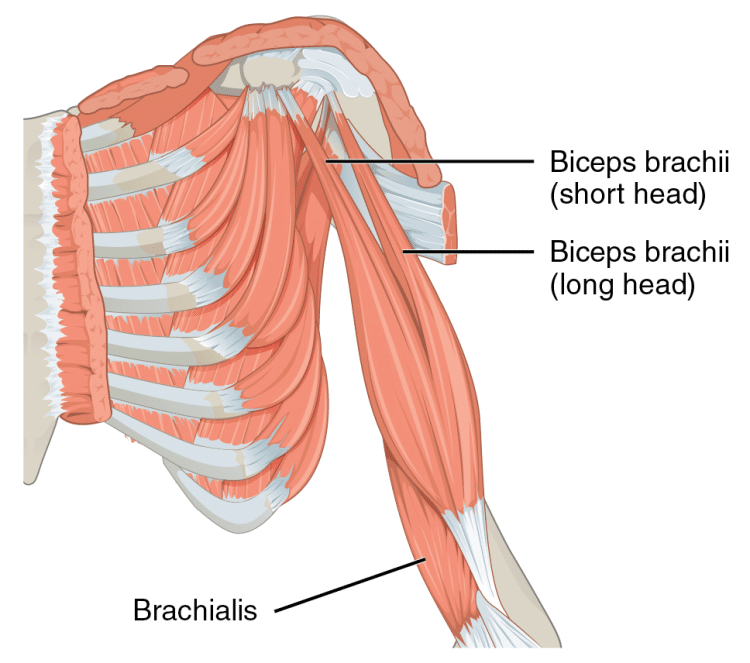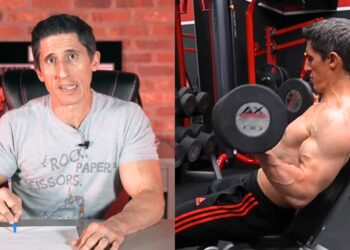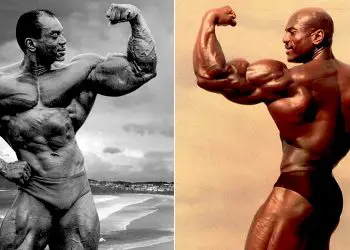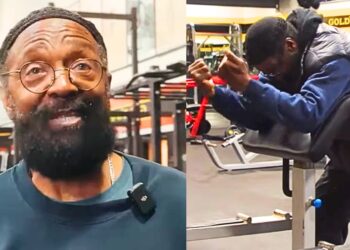Ask most bodybuilders what the best biceps exercise are, and invariably they’ll tell you that it’s barbell and dumbbell curls. These free-weight exercises are staples of most arm workouts.
And while barbell and dumbbell curls are undeniably effective, you can have too much of a good thing. Do the same exercises too often, and even the mighty barbell curl will start to lose some of its muscle-building power.
That’s where cable exercises come in. Using cables instead of or in addition to freeweights expands your exercise repertoire, allowing you to hit your biceps in an entirely new way. Also, cable exercises tend to keep your muscles under more constant tension, which means some cable biceps exercises may even be more effective than their freeweight counterparts.
In this article, we reveal nine of the best cable exercises for bigger, more muscular biceps.
Biceps Anatomy Basics

You don’t need a degree in anatomy to build impressive biceps. That said, knowing a little more about how the biceps works may help explain why some exercises are better than others for sculpting gargantuan guns!
The full name of the biceps is biceps brachii. This means two-headed arm muscle and refers to the fact that the biceps are made up of two distinct parts, which anatomists call heads (1).
Level Up Your Fitness: Join our 💪 strong community in Fitness Volt Newsletter. Get daily inspiration, expert-backed workouts, nutrition tips, the latest in strength sports, and the support you need to reach your goals. Subscribe for free!
The biceps have two origins, meaning it has two uppermost attachment sites. The short head originates on the scapula or shoulder blade, while the long head originates just above the shoulder joint. These two attachments merge to form a single muscle belly, which inserts onto the radius, which is the larger of your two forearm bones.
The biceps are a biarticular muscle, meaning it crosses two joints – the shoulder and the elbow. Because of this, it affects both of these joints, although its effect on the shoulder is relatively weak.
The biceps have three main functions:
- Flexion of the elbow – bending your arm
- Supination of the forearm – turning your palm upwards
- Flexion of the shoulder – raising your arm forward
9 Best Cable Arm Exercises for Bigger Biceps
Not sure how to begin beefing up your biceps with cable exercises? Here are nine of the best to get you started!
- Cable Curls
- Cable Hammer Curls
- Cable Reverse Curls
- Cable Supine Curls
- Behind the Back Single-arm Cable Curl
- Cable Concentration Curl
- Cable Overhead Curl
- Cable Preacher Curl
- Cable Spider Curl
1. Cable Curls
If you want to build bigger, more muscular biceps, barbell and EZ curls are hard to beat. That’s why almost every decent biceps workout includes one or both of these exercises. However, you may find you get even better results if you swap your freeweight bar for a cable machine.
Using cables means your biceps are under almost constant tension, producing more metabolic stress, a better pump, and, potentially, more muscle growth. You can use a straight or EZ bar as preferred, although the EZ bar is usually easier on your wrists.
How to do it:
- Begin by setting the machine to its lowest pulley.
- Stand facing the machine and grasp the bar with a shoulder-width grip.
- Starting with arms fully extended, curl the bar towards your shoulders.
Read all about cable biceps curls here.
2. Cable Hammer Curls
Cable hammer curls are so-called because, when you do them, you look a bit like you are hammering in a nail. As well as working your biceps, cable hammer curls hit your brachialis and brachioradialis muscles, which are located in your upper forearm/lower humerus.
These small but crucial muscles will make your forearms thicker and help push your biceps up to make them look bigger. You can do hammer curls with dumbbells, but the cable variation maybe even more effective. That’s because there is no drop-off in muscle tension at the end of each rep.
Doing hammer curls with a cable means using a rope handle, so you can adjust your hand-width as required. Also, using a rope increases forearm muscle activation and could help you build a firmer grip and more muscular lower arms.
How to do it:
- Attach a rope handle to a low pulley. Hold the handle with your thumbs nearest the ends.
- Stand up, brace your core, and pull your shoulders down and back. Pin your upper arms into your sides.
- Bend your elbows and curl the handles up to your shoulders. Keep your thumbs pointing up, i.e., in a neutral position.
- Extend your arms and repeat.
3. Cable Reverse Curls
If you’ve even done reverse curls before, it was probably as part of your forearm workout. However, this exercise is also an excellent biceps builder. Just like hammer curls, cable reverse curls work your biceps, brachialis, and brachioradialis, making them an excellent total arm exercise.
How to do it:
- Attach a straight bar to a low pulley and hold the handle using a shoulder-width, pronated (palms down) grip.
- Stand up, brace your core, and pull your shoulders down and back. Pin your upper arms into your sides.
- Bend your elbows and curl the handle up to your shoulders. Keep your wrists straight or, to increase forearm activation, flex them up and back at the top of each rep.
- Extend your arms and repeat.
4. Cable Supine Curls
Are you one of those people who simply cannot do curls without using your legs and back to lift the weight? If so, this is the exercise for you!
Cable supine curls are performed while lying flat on the ground, which makes it almost impossible to cheat. You probably won’t be able to lift as much weight as usual but, with this exercise, it’ll be your biceps doing all the work and not your lower body or back.
How to do it:
Level Up Your Fitness: Join our 💪 strong community in Fitness Volt Newsletter. Get daily inspiration, expert-backed workouts, nutrition tips, the latest in strength sports, and the support you need to reach your goals. Subscribe for free!
- Attach a straight or EZ bar to a low pulley. Sit on the floor with your legs straight and feet closest to the weight stack. Grab the bar with an underhand, shoulder-width grip.
- Lie down and straighten your arms. This is your starting position.
- Keeping your upper arms close to your sides, bend your elbows and curl the bar up to your shoulders.
- Extend your arms and repeat.
5. Behind the Back Single-arm Cable Curl
This exercise is the cable equivalent of incline dumbbell curls. Extending your arm behind you puts your biceps in a somewhat stretched position, hitting it from a very unusual angle. It also keeps your biceps under constant tension for more metabolic stress and a better pump.
Don’t go too heavy too soon with this exercise; overdoing it could lead to shoulder or elbow joint pain.
How to do it:
- Attach a D-shaped handle to a low pulley.
- With your back to the weight stack, take the pulley in one hand, step forward, and adopt a split stance for balance. Your arm should be extended behind you.
- Bend your elbow and curl the weight forward and up to your shoulder.
- Extend your arm and repeat.
- Do the same number of reps with the opposite arm.
6. Cable Concentration Curl
According to the American Council on Exercise (ACE), concentration curls are among the best exercises for fully engaging your biceps (2). That’s because they all but eliminate momentum as your upper arm is pinned against your inner thigh. Also, by working one arm at a time, you can really focus on your mind-muscle connection to get even more from this exercise.
Dumbbell concentration curls are a great exercise, but cables could make it even better, as there is tension on your biceps throughout the entire movement.
How to do it:
- Place a bench next to a cable machine and attach a D-shaped handle to the low pulley.
- Sit on the bench and grab the handle with your nearest arm. Place your upper arm inside and against your thigh.
- Keeping your arm in contract with your leg, bend your elbow and curl the handle up toward your shoulder.
- Extend your arm and repeat.
- Do the same number of reps on both arms.
- You can also do this exercise standing, i.e., bent over with your upper arm resting against your inner thigh.
7. Cable Overhead Curl
There are several reasons that the cable overhead biceps curl is such a popular exercise. Firstly, you can’t use your legs or back to lift the weight, so it’s very strict and effective. Secondly, most cable crossover machines are set up in front of a mirror, so you’ll get a great view of your biceps as you train them. Finally, who doesn’t like throwing up their arms and doing a double biceps pose?!
This exercise might not be the best biceps mass builder, but it’s a great way to end your arm workout and get a skin-splitting pump.
Find out how to do this exercise here.
8. Cable Preacher Curl
Preacher curls were one of Mr. Olympia Larry Scott’s favorite biceps exercises. Scott, who won the Mr. Olympia title in 1964 and 1956, was famous for his fantastic biceps’ development. He was so commonly associated with preacher curls that they are often called Scott curls in his honor.
On the downside, when you do preacher curls with a barbell or dumbbells, all muscle tension vanishes as your arms approach vertical. As such, your effective range of movement is limited to a little less than 90-degrees.
However, doing preacher curls with a cable means that you can bend your arms fully with no loss of muscle tension, resulting in a better biceps workout.
Read more about cable preacher curls here.
9. Cable Spider Curl
Spider curls are an unusual exercise typically done using a barbell or dumbbells. However, they work even better with cables! Spider curls involve lying face down on an incline bench, which means you cannot use your legs or upper back to help lift the weight.
Muscle tension increases as you hit the top of each rep, producing a deep burn and strong pump. This exercise primarily targets the short head of your biceps, which could help you build a higher biceps peak.
How to do it:
- Place a bench in front and a couple of feet away from a low pulley. Set the bench to about 45-degrees and use a straight bar or EZ bar as required.
- Lie face down on the bench and grab the handle. Your arms should be straight.
- Bend your elbows and curl the handle up to your shoulders.
- Extend your arms and repeat.
Cable Arm Workout
A comprehensive arm workout requires the use of a variety of training equipment, such as dumbbells, barbells, cable machines, and bodyweight exercises. However, the following sample cable machine workout is effective in targeting both the biceps and triceps muscles.
| No. | Exercise | Sets | Reps | Recovery |
| 1 | Cable Hammer Curls | 3 | 8-12 | 90 seconds |
| 2 | Cable Reverse Curls | 3 | 8-12 | 90 seconds |
| 3 | Single arm cable curl | 2 | 10-12 | 60 seconds |
| 4 | Cable spider curls | 2 | 10-12 | 60 seconds |
| 5 | Cable concentration curl | 2 | 12-15 | 45 seconds |
Cable Exercises for Biceps – Wrapping Up
While there is nothing wrong with building your arm workouts around dumbbell and barbell curls, free weight exercises do have limitations. For starters, at the start and mid-point of each rep, there is often very little tension on your biceps, which may make some exercises less effective.
Also, doing the same free-weight biceps exercises over and over again can become boring, and boredom can undermine your motivation as well as your muscle-building progress.
An obvious fix for both these problems is incorporating more cable biceps exercises into your arm workouts.
You can go all cable all the time, or simply replace 1-2 free-weight exercises with their cable equivalent. Both options could help breathe new life into biceps workouts and reignite muscle growth.
Regardless of which option you choose, cable biceps curls could get you out of your current biceps building rut and help you build the arms of your dreams!
References:
- Encyclopedia Britannica: Biceps Muscle Anatomy https://www.britannica.com/science/biceps-muscle
- American Council on Exercise (ACE): ACE Study Reveals Best Biceps Exercises acefitness.org
Interested in measuring your progress? Check out our strength standards for Barbell Curl, Incline Dumbbell Curl, Dumbbell Curl, and more.








